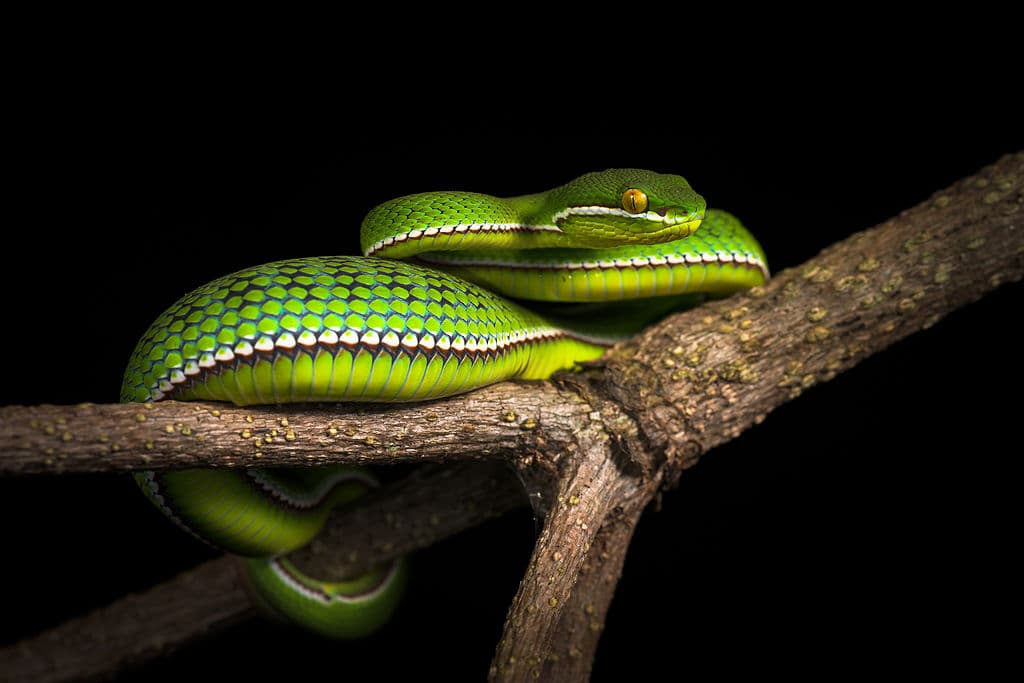Among 60 snake species in Cambodia, 17 of them are venomous, and there are 12 venomous snakes that usually pose dangers to people. Here, we divided snakes into two types: neurotoxic snakes and hemotoxic snakes. We are going to discuss both types and talk about 12 most dangerous and venomous snakes in Cambodia today. Make sure to always be careful when you go hiking in the mountains, and avoid the snakes you see below.
Hemotoxic Snakes

The term hemotoxic refers to the venom that specifically destroys red blood cells which affects internal organs and tissues. This kind of venom disrupts blood clotting which can lead to heart attacks, internal bleeding, limb loss, organ collapse, etc. Damage from hemotoxic venom is very painful, and it can also cause permanent damage or even death in severe cases. Hemotoxic snakes include boomslang, copperheads, and other vipers.
Banded Krait
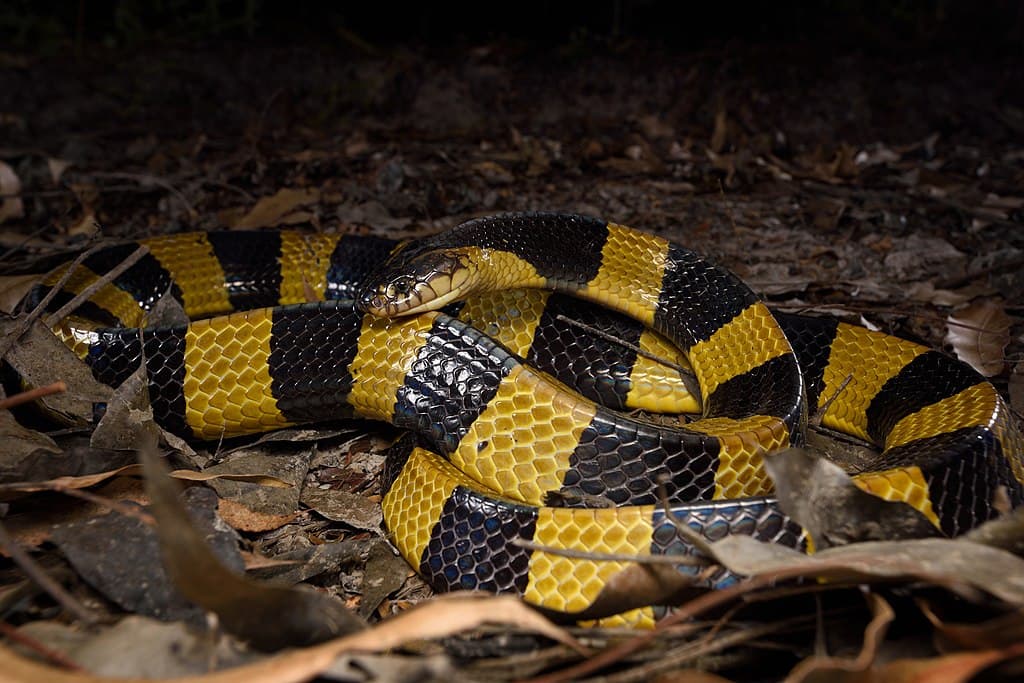
Banded krait (ពស់ក្រាយលឿង-ខ្មៅ) is the largest krait species found in the Indian Subcontinent, Southern China, and Southeast Asia, including Cambodia. A banded krait can grow from 2.1 meters to 2.7 meters, and you cannot mistake that appearance for any snake. You can easily identify them by the alternate black and yellow cross bands on their bodies.
The banded kraits inhabit a wide range of habitats such as agricultural lands, forests, rodent holes, termite mounds, and more. Usually, they like areas that are close to the water which is sometimes near human settlements, especially villages. This is why it is also common for their bites on humans, especially young kids. The thing is that banded krait does not always inject venom in a defensive bite. That is because they rather save their venom for hunting prey instead.
Despite the deadly venom, banded kraits are shy and sluggish during the daytime. However, they are not afraid to bite when harassed. Banded kraits are nocturnal and they often come out in the rain as well. They usually hunt at night, mostly on other snakes but also fish, frogs, skinks, and snake eggs. When hunting, they bite to inject venom into their prey before swallowing the prey whole head first.
If they do bite humans and inject venom, the results won’t be pretty. Banded krait can produce highly toxic it can attack the nervous system directly. Some of the common symptoms of these venomous snakes are abdominal pain, bleeding, diarrhea, dizziness, paralysis, vomiting, and even kidney damage. In case of a large dose of venom, the victim can suffer from respiratory failure which leads to death.
Blue Krait
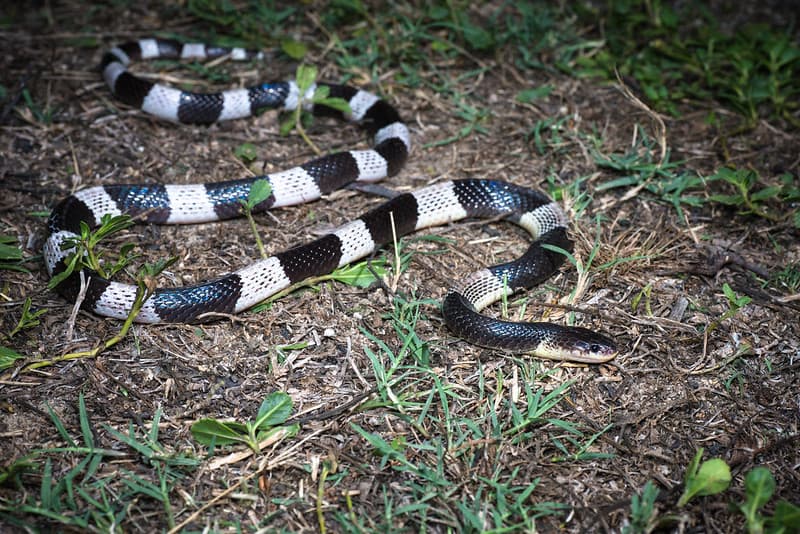
The blue krait (ពស់ក្រាយស-ខ្មៅ) is a venomous snake species with a distinctive look. The irony is that blue is not the color of the snake at all. A blue krait has a dark head with blue-black or yellowish-white crossbands from the head to the tail. Generally, the dark head is the first band of the snake. A blue krait can grow to about 1 meter long, or even up to 1.6 meters. Not a big snake, its fangs are also small which is why they inflict painless bites or bites without fang marks.
Not different from many other venomous snakes in Cambodia, this one is also nocturnal and secretive elapids that hide during the day. They are so shy they often attempt to cover their head with their tail during confrontations. Because they are so docile during the daytime, this is why many snake handles can handle them with bare hands. As for feeding, blue kraits feed on other snakes even those of their own kind. Apart from snakes, these active hunters also prey on amphibians and lizards as well as small mammals and other animals they can catch.
Blue kraits prefer to live in rocky areas and waterways, but they are also common in deciduous shrubby areas. So you will also find them in hill forests, plantations, moist evergreen forests, rice dams, and rice fields. That is not all, sometimes people also come across them in cities and villages. The good thing is that they are not aggressive or defensive, and they only bite when provoked or threatened.
Venom
When they do bite, their venom is powerful enough to attack the human nervous system and force it to shut down. Death may occur within 12 to 24 hours after the envenomation due to respiratory failure from paralysis. Since its venom is 15 times more potent than that of the common cobra, even the juvenile blue kraits can deliver a deadly bite. The most dangerous part is that there is very little to no pain at the bite location. People in remote and small villages usually sleep on the floor, and they don’t even know they are bitten.
Indochinese Spitting Cobra
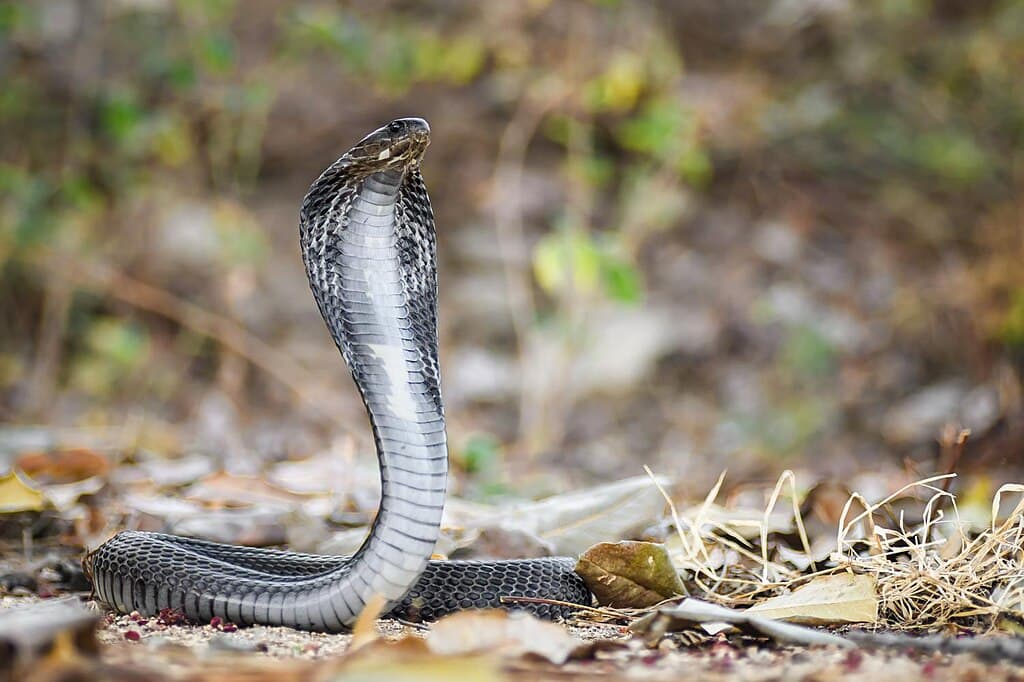
Being one of the most venomous snakes in Cambodia, Indochinese spitting cobra (ពស់វែកដំបូក) is a very fearsome elapid. It has a slender build than other cobras, and it has various hood marks which could be confusing. The hood mark of Indochinese spitting cobras can be spectacled-shaped, irregular, or even missing together. At the same time, their colors also vary, usually from black, brown, to grey; usually with white spots or stripes. An average Indochinese spitting cobra can grow up to 1.2 meters or longer.
Indochinese spitting cobras are common in hills, lowlands, plains, and woodland as well as jungle habitats. Sometimes they come to human settlements due to the food availability, rodents. The interesting thing about them is that these snakes are nocturnal so they are more aggressive during nighttime. When threatened at night, they are more likely to stand their ground, rear up, display their hood, and spit venom. On the other hand, these cobras are more timid and often seek refuge during the daytime.
As a “true spitter”, this cobra ejects a mist of venom rather than a stream at a range of a meter. It usually aims at the eyes, and the venom inflicts immediate stinging burning pain or even blindness. If spitting venom does not work, it will strike and bite. The thing that you have to know is that Indochinese spitting cobra tends to hold on and chew when biting. Its bite is lethal to humans, causing pain and swelling along with necrosis around the wound. Without immediate treatment, consequence asphyxiation and paralysis will occur, leading to death.
King Cobra

The almighty king cobra (ពស់វែករនៀម) is no stranger to people, and it has a fearsome reputation for many reasons. As the world’s longest venomous snakes, these venomous snakes can grow up to 5.8 meters. A king cobra has olive green skin but also black, brown, or yellow depending on where it comes from. Usually, it has white or yellowish crossbars or chevrons.
Being so powerful, king cobras prey on birds lizards, and other snakes, even its own kind. They use their forked tongue to pick up chemical information by picking scent particles of their prey. King cobras bite and inject venom into its prey to paralyze it before swallowing it whole. Their common habitats are bamboo thickets and dense or open forests that are next to agricultural areas and dense mangrove swamps.
For those who don’t know, a king cobra can raise one-third of its body, make eye contact, and growl when threatened. Considering its length, one-third of its body is enough to make it taller than an average man. If the enemy does not back down, it is not afraid to charge and strike with its deadly venom. The toxins from its venom affect the victim’s central nervous system, causing blurred vision, drowsiness, severe pain, and vertigo. If the envenomation is serious, it can lead to cardiovascular collapse, followed by death from respiratory failure. The sad thing is that king cobras are now listed as Vulnerable on the IUCN Red List due to habitat destruction. People also poach them for their meat and skin to use in traditional Chinese medicine.
Monocled Cobra
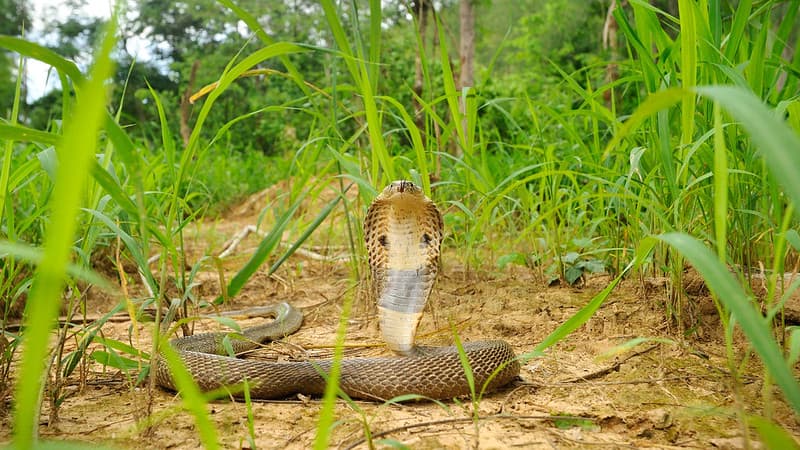
Here we have one of the most venomous cobras in Cambodia, the monocled cobra (ពស់វែកក្របី). This cobra could be in many different colors such as blackish, brown, gray, or yellow. But you can easily recognize a monocled cobra by the O-shaped hood pattern on the rear of its hood. An adult monocled cobra can grow up to 1.5 meters on average, and the longest specimen was 2.3 meters.
The almighty monocled cobras are found across Cambodia, usually in forests, grasslands, mangroves, paddy fields, shrublands, and swamps. Sometimes they also find their way into human settlements, even in the cities. Where they inhabit, they are active at dusk to hunt fish, small mammals, and snakes. Some of them live in rodent burrows while others live in tree holes, and there are semi-aquatic ones live in dykes. These cobras are quite terrestrial, and they are not afraid to strike when threatened. You can notice their defensive behavior when they raise their body anterior portions, spread their hood, and loudly hiss.
Monocled cobras have strong venom that can block nerve transmission that leads to flaccid paralysis and even death by respiratory failure. The symptoms start to manifest and progress within the first to fourth hours before leading to death. Some of the most common symptoms are drowsiness, hypotension, numbness, and pain around the bite site while necrosis begins to develop. Besides biting, monocled cobras also have the ability to spit venom so be aware of that. Though some countries harvest them for food and skin trade as well as traditional medicine, their population is doing okay.
Red-Headed Krait
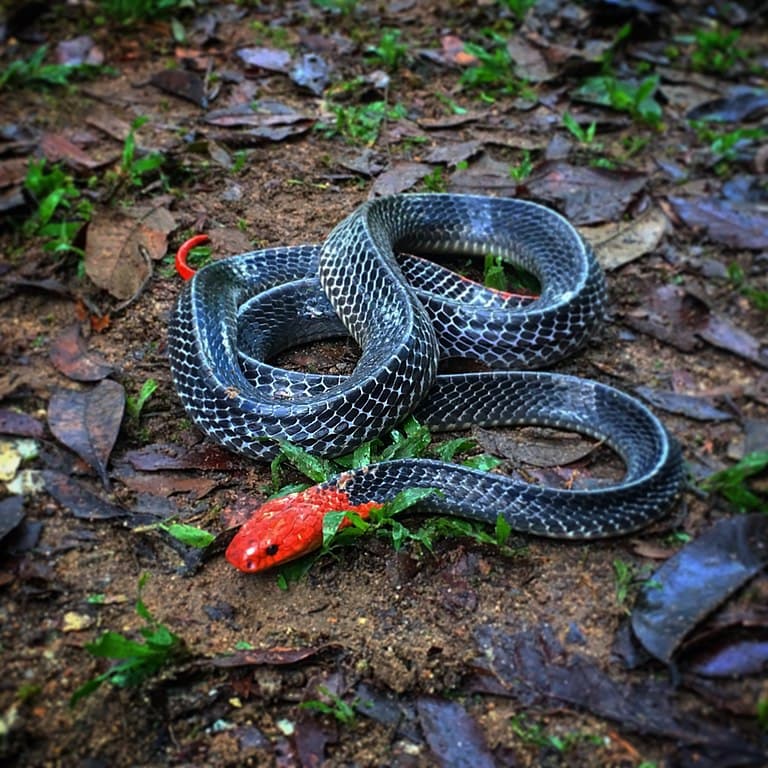
I fall in love with the coloration of this venomous snake, it is just so eye-catching. The red-headed krait (ពស់ក្រាយក្បាលក្រហម) has a very beautiful coloration that you can easily recognize by the bright red head and tail. Some specimens might have orange or yellow heads and tails, and the coloration generally extends slightly onto the neck. As for the body, it has large smooth black scales that are very glossy and striking to look at. A red-headed krait can grow at an average length of 1.2 to 1.5 meters, or up to 2.1 meters.
So common in Southeast Asian countries, these snakes inhabit rainforests in hilly and mountainous regions. As for human habitations, it is very rare to come across one. Red-headed kraits are nocturnal, and they are also partially aquatic. Where they live, they feed primarily on other snakes as well as caecilians, frogs, lizards, skinks, small mammals, and snake eggs.
The behavior of this krait species is also rather interesting because they refuse to strike until they are subjected to prolonged teasing. These kraits do not attack humans out of nowhere, they are more lethargic and sluggish, and extremely inoffensive during the daytime. However, they are active and very very dangerous at night. Red-headed kraits rarely bite, but their venom is deadly.
Once bitten, the victims will experience some symptoms during the first 20 minutes to several hours. Those include diplopia (double vision), dysphagia (difficulty in swallowing), headache, hypersalivation, and vomiting. At the same time, the victims will be incapable of opening their eyelids due to the effects of the venom. The neurotoxin from their venom will cause paralysis followed by death by asphyxiation because the victims can no longer breathe.
Neurotoxic Snakes
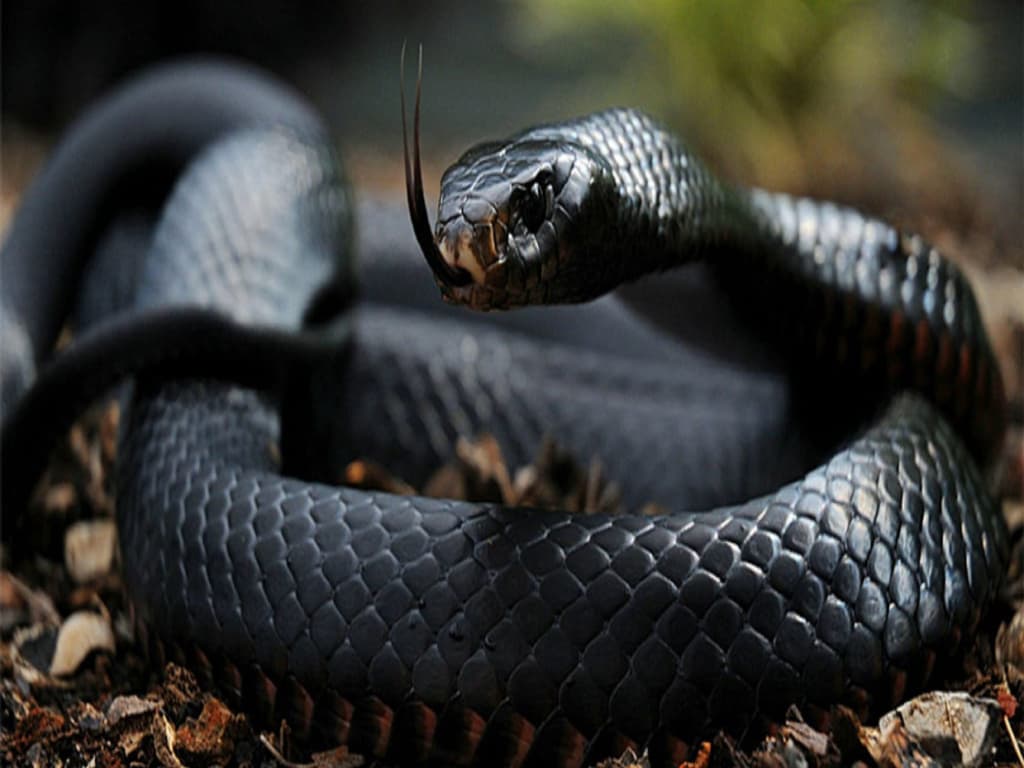
As for this type of venom, it affects the nervous system which can cause muscle paralysis and unconsciousness. At the same time, it is also destructive to nerve tissue with an immobilizing effect. So it either makes a victim’s body become limp or turn rigid by attacking their nerve cells. The common symptoms from this venom could be pain at the bite site followed by paralysis feeling settling in. That is when the victim can no longer control their body such as keeping their eyes open or smiling. Some examples of neurotoxic snakes are black mambas, coral snakes, rattlesnakes, and sea snakes.
Beaked Sea Snake
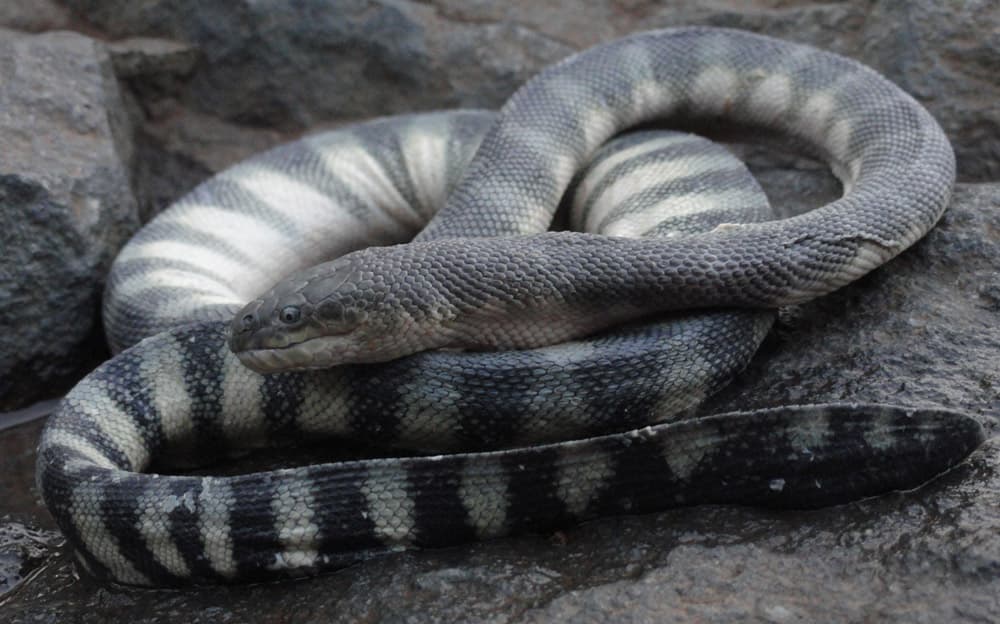
As for this common sea snake, it goes by many names including the beaked sea snake, hook-nose sea snake, or the Valakadeyan sea snake. Beaked sea snake (ពស់សមុទ្រ) is a highly venomous sea snake species, responsible for more than 50% of all sea snake bites. It got its name from the beaked or hooked appearance of its nose, and it is not difficult to remember. This sea snake has a rather spooky appearance, with the color and the look of the scale alignment. It has gray upper half, with whitish or yellowish lower half and sides along with gray-blue bars. An adult common sea snake can grow up to 1.52 meters on average.
The common sea snakes are active both day and night, spending most of their time in the water. They can dive up to 100 meters deep and stay underwater for up to 5 hours before resurfacing. Beaked sea snakes inhabit bays, coastal lagoons, estuaries, harbors, lakes, mangrove forests, rivers, and shallow open seas. As water snakes, they primarily feed on fish that they can find, especially catfish, pufferfish, and shrimps.
As one of the most dangerous and venomous snakes in Cambodia, their venom is definitely the thing to watch out for. Being quite aggressive is like the icing on the cake, except for the fact that that cake can kill you. One bite from this snake is enough to kill around 50 people, so you can tell how venomous it is. This is why immediate medical attention is required if bitten. Bites are common in muddy water areas where the snake’s vision is poor.
Status
People don’t leave them alone; hence, the threats to their population such as collection for skins and venom, entanglement, and pollution. Entanglement is usually in fishing and shrimp-trawling nets because they are very vulnerable when they hunt shrimp. Meanwhile, pollution also leads to habitat loss. At least, the good thing is their population is doing well in nature.
Eastern Russell’s Viper
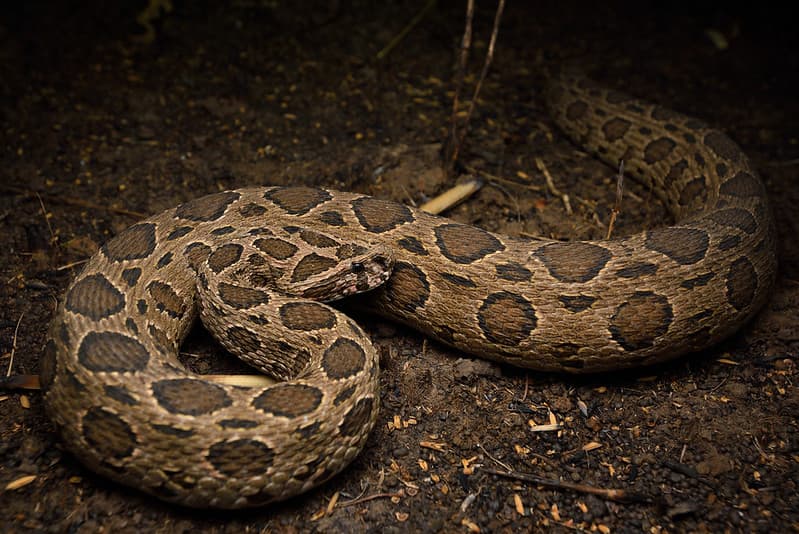
When it comes to the most dangerous snakes in Cambodia, eastern Russell’s vipers (ពស់ពព្លាក់) have to be on the list. An eastern Russell’s viper has a grayish or olive color pattern on its dorsal along with small spots between the large spot rows. It can grow from 1.2 meters to 1.9 meters, and the colorations could be brown, deep yellow, or tan.
Not different from other vipers out there, this species also prey on arthropods, land crabs, lizards, rodents, scorpions, and small reptiles. They are more common in bushy areas, coastal lowlands, grassy areas, open areas, plains, scrublands, and urban settlements. You won’t find them in dense forests or vegetations but they may hide in caves, soil cracks, or under leaves. Eastern Russell’s vipers are also found in farms, plantations, and along the hills.
Eastern Russell’s vipers get hostile very easily and move very quickly when they intend to bite. When that happens, these snakes can deliver the maximum possible dose of venom to the victims. The first symptoms would be pain and swelling at the site followed by internal bleeding seen in gums, sputum, and urine. After that, the blood pressure and heartbeat rate start to decline. Victims will also see blistering and superficial necrosis at the site along with pain for weeks. During those weeks, there may be also blood clots, facial swelling, and vomiting before death by cardiovascular, kidney, and respiratory failure.
Large-Eyed Pit Viper

The name says it all, the large-eyed pit vipers (ពស់ខៀវភ្នែកធំ) indeed have relatively large eyes. They have a broad triangular-shaped head with large golden yellow eyes. An average adult large-eyed pit viper does not grow longer than one meter as this snake species is quite small.
These venomous snakes are common in bush vegetations, large plants, and on small trees. Though encounters with them are not common, they may be found in cultivated lands and open countrysides. The possibility of them entering gardens and residences in search of prey is not zero. Where they live, they feed on a wide range of animals such as lizards, small birds, small mammals, and tree frogs.
While they are rather shy, large-eyed pit vipers are not afraid to bite when provoked. Their venom can cause pain and swelling on the site before causing bleeding issues and shock. There are also systematic symptoms such as diarrhea, headache, lightheadedness, nausea, seizures, tissue necrosis, and vomiting before death if without treatment.
Malayan Pit Viper
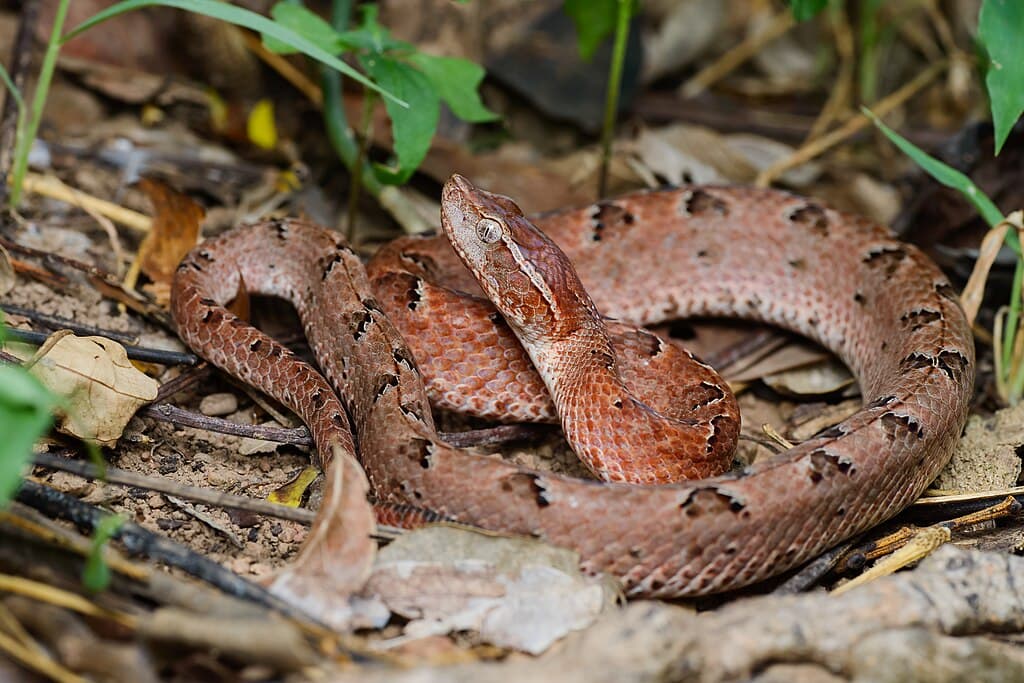
Small but deadly, Malayan pit vipers (ពស់ស្រកាចាស់) are one of the most dangerous snakes in Cambodia. The dorsal of the snake is grayish, pale brown, or reddish, with two series of large dark brown, black-edged triangular blotches. Another interesting thing is that it is the only Asian pit viper with large brown scales and smooth dorsal scales. It can usually grow as long as 91 centimeters.
These vipers inhabit a wide range of habitats such as forests around plantations, and unused and overgrown farmland, orchards, and plantations. However, their most favorite habitats are bamboo thickets and coastal forests where food is abundant. Mostly, they are active at night but some of them also hunt during the day. The Malayan pit vipers primarily feed on mice and rats so these snakes are also common near large rice paddy fields. Apart from rodents, they also prey on frogs, lizards, and even birds sometimes.
Guess what they have, a combination of bad-tempered and quick striking. Malayan pit vipers are responsible for hundreds of bites in Malaysia as well as other Southeast Asian countries. The interesting part is that they often remain in the same spot hours after biting people. The venom from this pit viper causes local swelling along with severe pain and tissue necrosis, and deaths are not common. Along with that, discoloration or blistering on the sites is also common. However, many victims often go through amputated or dysfunctional limbs due to antivenom or early treatment.
Vogel’s Pit Viper
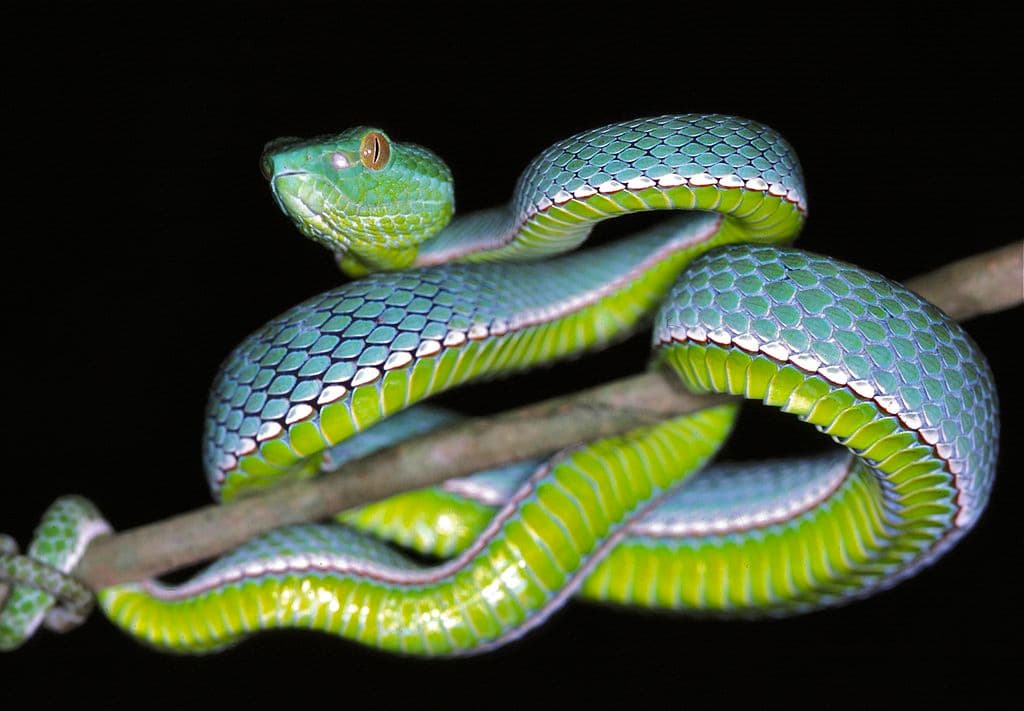
There is not a lot of information about these dangerous snakes, but this is what I can find. By the look, you can tell that their appearance is no different from other typical green pit vipers. The thing that you can easily recognize in them is the stripe (white, whitish-blue, or whitish-yellow) along their lower flanks. Sexual dimorphism exists in this snake, with males being dark green while females are pale green. Males can grow to 80 centimeters and females can grow to 110 centimeters.
Vogel’s pit vipers (ពស់ខៀវ) are mainly from moist evergreen forests so hikers are more likely to encounter them. They are largely arboreal but they also venture vegetated grasslands. Vogel’s pit vipers are nocturnal so they search for food at nighttime. Where they live, these ambush predators wait patiently for a potential meal such as frogs, rodents, and skinks. When the opportunities arise, they grab their prey and hang it in the air. Being front-fanged, these vipers can bite to inject venom, release, and then chew or inject more venom with another bite.
White-Lipped Pit Viper
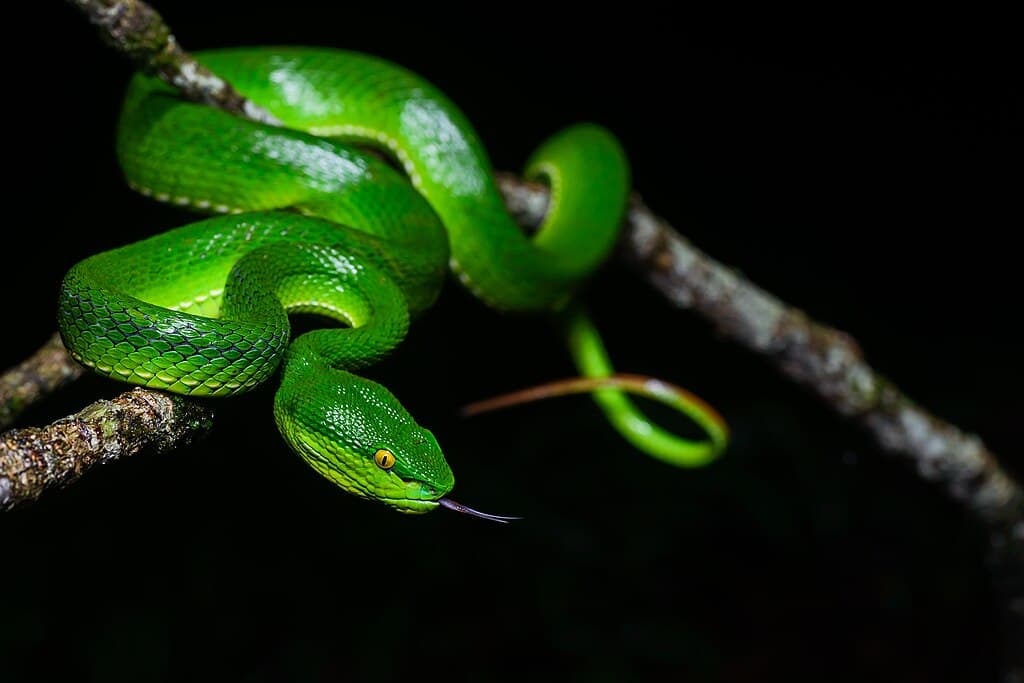
Small but deadly, white-lipped pit vipers (ពស់ហនុមាន) are one of the most dangerous snakes in Cambodia. This pit viper has a reputation for being lethal among hikers who like to venture into forests and mountains. It is not difficult to recognize one as well, that green body and reddish tail say it all. A white-lipped pit viper has a bright green or yellow-green body, with orange or yellow iris. Males normally grow to 60 centimeters while females can grow up to 81 centimeters.
White-lipped pit vipers are arboreal, but their ways of hunting are rather different from their fellow arboreal serpents. While a majority of arboreal snakes strike and release, this one holds on to the prey until it dies. The prey are birds, small frogs, and small mammals. As for their habitats, these snakes live in agricultural areas, forests, rural gardens, and shrublands as well as near human habitations. White-lipped pit vipers are nocturnal and solitary, and they only come together during the breeding season which is May.
White-lipped pit vipers are fearsome for a reason, the results from their bites are from mild to death. That is probably the scariest part because you won’t know which one you are going to experience. When approached too closely or touched, they will bite quickly instead of escaping. The common symptoms are abdominal pain, diarrhea, dizziness, collapse, convulsions, headache, nausea, and vomiting. Extensive bleeding is also common, along with blistering, bruising, pain, and swelling on the local site.
Related Post: Main Types Of Vultures In Cambodia
